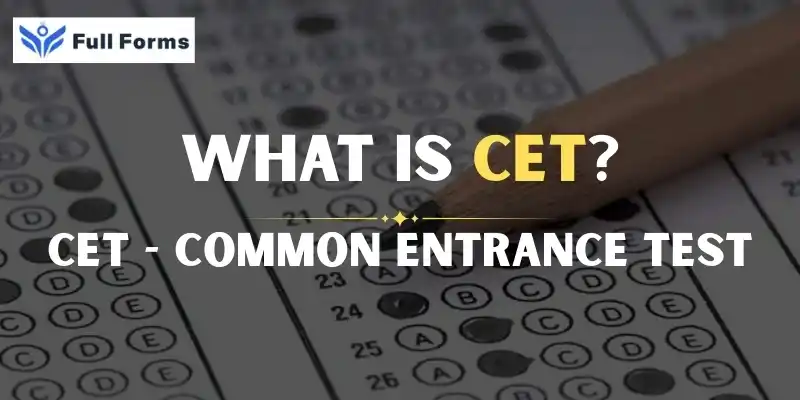Common Entrance Test
(CET)

Description
Common Entrance Test (CET): Your Pathway to Higher Education in India
The education system of India is vast. There are thousands of aspirants applying for very limited seats in some recognized institutions across different parts of the country. Therefore, to streamline the process and maintain a good merit-based selection, an entrance exam method known as CET has been introduced by many state governments and adopted by several reputed institutes. Through this Unified approach, students can demonstrate their intellectual ability and secure admission against professional courses like engineering, medical, management, law, or agriculture.
What is CET?
The Common Entrance Test (CET) is the competitive examination at both State and National levels for entry into undergraduate as well as postgraduate courses. While board exams test the general academic performance, CET particularly evaluates a candidate's aptitude, subject knowledge, and problem-solving skills regarding the preferred field of study to which he/she is applying.
Different states conduct their own versions of CET, such as:
- MHT CET – Maharashtra
- KCET – Karnataka
- TS EAMCET for Telangana
- AP EAMCET for Andhra Pradesh
- WBJEE for West Bengal
They cover the main avenues to government and private colleges of engineering, medical, pharmacy, agriculture, and other professional courses.
Reasons and Importance of CET
The Common Entrance Test has come into force so as to make a fair, merit-based, transparent way of getting admission into professional education programs. This is what makes CET important:
- Standardized Assessment: In this way, through a common entrance test from various educational boards and backgrounds, the standard of students can be uniformly assessed.
- Merit: This ensures that only the best candidates get selected based on their performance rather than on personal influence or donations.
- Efficient entry process: Common Entrance Test merges several entry tests into one central test.
- Wider reach: It gives equal chances to students coming from both urban and rural setups.
CET Pattern
Even though the pattern varies by state and by course slightly, most CETs use the MCQ format. They may be offered offline or computer-based. Major components usually include:
- Physics
- Chemistry
- Mathematics (for engineering aspirants)
- Biology (for medical and agricultural courses)
- English & Aptitude (in some management and law exams)
The CET essentially contains syllabi from the Class 11 and 12 NCERT curriculum. Students can easily prepare for it along with their regular school studies.
Eligibility Criteria
Eligibility to appear at the CET may vary from state to state and course to course, but the basic common criteria are as follows:
- Educational Qualification: The candidate must have passed/ appeared in the 10+2 or equivalent examination with relevant subjects.
- Home Requirements: Most state-level CETs need the student to be a home of the respective state.
- Minimum Marks: A minimum percentage in the qualifying exam (usually 45–50%) is required to be eligible.
CET Benefits
- Fair Chance: No matter the student's background or wealth, CET makes sure all fight on the same ground.
- Lowers Entry Worry: Rather than writing many tests for many colleges, students may study for one test that gives numerous options.
- Cost-Effective: With just a single application fee and travel for one exam, CET turns out to be much more economical for families.
- Government Regulation: Because CETs are done by government bodies or approved institutions, the process is transparent and there is no corruption.
Challenges and Limitations
Despite the benefits, CET has some challenges:
- Great Competition: With lakhs of students sitting for the exam every year, it is not easy to get a top rank.
- Much Pressure: CET acts as a do-or-die moment for most students thereby increasing their anxiety levels and making them more stressed.
- No Standardization Across States: Each state has its version of CET. This becomes difficult for a student if he wants to take admission in more than one state.
Preparation Tips
- See a paper of the past years.
- Practice mock tests under time conditions.
- Use NCERT books since most questions come from their syllabi.
- Work on time management during exams without loss of accuracy.
Future of CET
As the education system is pivoting to embrace national-level entrance tests, such as CUET for central universities, therefore a resultant growing demand is found to standardize CETs across states. One common national entrance test for all professional courses can bring about uniformity in the system and do away with redundancy while making it accessible to students across India.
Conclusion
The Common Entrance Test (CET) is central to the education system of India, managing to keep merit as well as fairness and transparency alive in the process of college admissions. Though an exercise that does pose certain challenges, it has proven to be among the most potent mechanisms for assessing student ability to pursue professional education. With adequate preparation accompanied by a positive mindset, CET can open up vast academic and professional vistas for millions of students.
